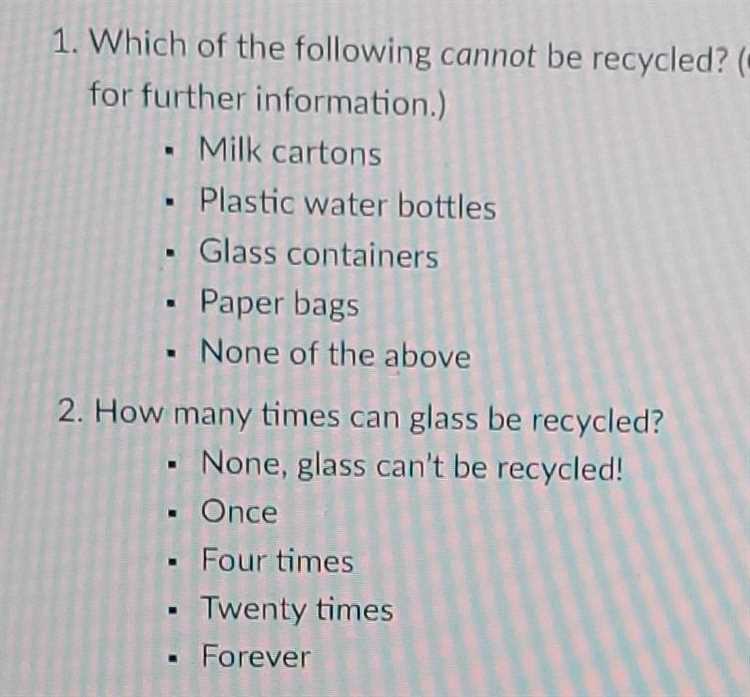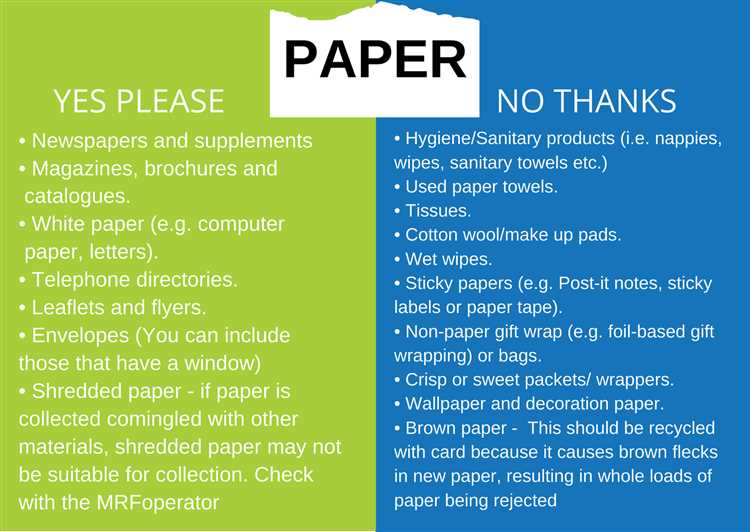
Recycling is an important way to reduce waste and protect the environment. However, not all materials can be recycled. It’s important to know what can and can’t be recycled in order to ensure that we are properly disposing of our waste.
Plastic bags are one of the most common non-recyclable items. Many recycling facilities are not equipped to handle plastic bags, so they often end up contaminating the recycling stream. Instead, it is recommended to reuse plastic bags or dispose of them in designated drop-off locations.
Styrofoam is another item that cannot be recycled in most places. Styrofoam is made of polystyrene, which is a type of plastic that is not easily recyclable. It is best to avoid using Styrofoam products whenever possible and opt for alternatives like paper or biodegradable materials.
Broken glass is also not recyclable. While glass bottles and jars can be recycled, broken glass poses a safety hazard to recycling workers and can contaminate the recycling stream. It is important to dispose of broken glass properly in a sealed container, like a cardboard box or a plastic bag, to prevent injuries.
In conclusion, knowing what can’t be recycled is just as important as knowing what can be. By avoiding non-recyclable items and properly disposing of them, we can help ensure that our recycling efforts are effective and beneficial for the environment.
- Plastic Bags and Wrappers
- Styrofoam Products
- Reasons why Styrofoam is non-recyclable:
- Types of Styrofoam products that cannot be recycled:
- Broken Glass
- Food Soiled Paper
- Electronic Waste
- 1. Batteries
- 2. Light Bulbs
- Hazardous Materials
- Examples of hazardous materials include:
- Q&A:
- Why can’t plastic bags be recycled?
- What should I do with broken glass that cannot be recycled?
- Can I recycle paper towels?
- What should I do with old batteries?
Plastic Bags and Wrappers

Plastic bags and wrappers are common household items that cannot be recycled. These items are typically made from a type of plastic called low-density polyethylene (LDPE), which is not easily recyclable. Plastic bags and wrappers are used for packaging various products, such as groceries, clothing, and other consumer goods.
Although some stores offer plastic bag recycling programs, the majority of plastic bags and wrappers end up in landfills or as litter. When plastic bags and wrappers are thrown away improperly, they can become a major environmental problem. They are lightweight and can easily blow away, ending up in waterways, trees, and other natural habitats.
Additionally, plastic bags and wrappers can cause harm to wildlife. Animals can mistake them for food and ingest them, leading to health issues and even death. Plastic bags and wrappers can also become entangled around animals, causing injury or suffocation.
To reduce the negative impact of plastic bags and wrappers, it is recommended to use reusable alternatives, such as cloth bags or containers. Many countries and cities have also implemented plastic bag bans or fees to encourage people to switch to more sustainable options.
Overall, it is important to be mindful of the disposal of plastic bags and wrappers and to opt for more environmentally friendly alternatives whenever possible.
Styrofoam Products
Styrofoam, also known as expanded polystyrene (EPS), is a non-recyclable material that is commonly used in the packaging industry due to its lightweight and insulating properties. However, it poses a significant environmental challenge because it is not biodegradable and can take hundreds of years to decompose in landfills.
Reasons why Styrofoam is non-recyclable:
- Complex Composition: Styrofoam is made up of a complex mixture of chemicals, making it difficult to break down and recycle.
- Lightweight and Fragile: Due to its lightweight nature, Styrofoam easily breaks into small particles, which makes it impractical to collect, sort, and recycle.
Types of Styrofoam products that cannot be recycled:

- Styrofoam cups and plates
- Styrofoam take-out containers
- Styrofoam packaging peanuts or loose fill
- Styrofoam trays and food containers
- Styrofoam insulation boards
- Styrofoam egg cartons
It is important to note that while Styrofoam cannot be recycled, there are alternatives available. Many companies have started using biodegradable and compostable alternatives to Styrofoam packaging materials, which are more environmentally friendly.
To reduce the negative impact of Styrofoam on the environment, it is recommended to avoid purchasing products that are packaged in Styrofoam whenever possible. Additionally, proper disposal of Styrofoam is crucial. Contact your local waste management facility to inquire about Styrofoam drop-off locations or recycling programs in your area.
Broken Glass
Broken glass is another item that cannot be recycled. While glass itself is a recyclable material, broken glass poses a safety risk to the workers at recycling facilities. Small shards of glass can cause injuries and contaminate other recyclable materials, making them unsuitable for recycling.
If you have broken glass, it is important to handle it with care. Place it in a sturdy, puncture-proof container, such as a cardboard box, and seal it properly. Then, you can dispose of it in the regular trash. Do not try to recycle broken glass, as it can cause harm to the people who handle the recycling process.
It is also worth noting that not all types of glass are recyclable. Items such as light bulbs, windowpanes, and mirrors are made of different types of glass and cannot be recycled along with glass bottles and jars. These items should be disposed of in the regular trash as well.
To reduce the amount of broken glass waste, it is important to handle glass items with care. Avoid dropping or knocking over glass objects to prevent them from breaking. Additionally, consider reusing or repurposing glass containers instead of throwing them away.
Remember: Broken glass is not recyclable and should be handled and disposed of properly to ensure the safety of recycling facility workers and to prevent contamination of other recyclable materials.
Food Soiled Paper
Food soiled paper refers to any paper product that has come into contact with food or food waste. This includes items such as used paper plates, greasy pizza boxes, and stained napkins. Although paper is generally recyclable, food soiled paper cannot be recycled due to the potential contamination it contains.
When food grease or other food residues come into contact with paper, it can make the paper no longer suitable for recycling. The oils, stains, and remnants of food can contaminate the paper recycling process, making it difficult to separate and recover the paper fibers.
Examples of food soiled paper that should not be placed in the recycling bin include:
- Used paper napkins and tissues
- Paper towels with food residues
- Waxed or plastic-coated paper
- Paper takeout containers with food residues
- Greasy or dirty pizza boxes
- Used coffee filters
- Paper plates with food residues
- Used paper cups
To properly dispose of food soiled paper, it should be placed in the regular trash or composted if the municipality allows it. Composting is a more sustainable option as it allows the paper to break down naturally and return to the earth as organic matter.
Remember to always check with your local recycling guidelines and composting regulations to ensure proper disposal of food soiled paper and other waste materials.
Electronic Waste
Electronic waste, commonly referred to as e-waste, consists of discarded electronic devices that have reached the end of their useful life. These devices often contain hazardous materials, such as lead, mercury, and cadmium, which can pose a serious threat to the environment and human health if not properly disposed of.
While many electronic devices can be recycled, there are also several types of e-waste that cannot be recycled due to various reasons. These include:
1. Batteries
Batteries, including rechargeable batteries and button cell batteries, should not be placed in regular recycling bins. They contain toxic chemicals that can leak into the environment if not handled properly. Many communities have special drop-off locations for battery recycling, so be sure to check with your local waste management facility for proper disposal options.
2. Light Bulbs
Fluorescent tubes, compact fluorescent lamps (CFLs), and other types of light bulbs contain small amounts of mercury, making them unsuitable for recycling. It is important to handle these bulbs with care and seek out local recycling programs or hazardous waste facilities that can properly dispose of them.
Other examples of electronic waste that cannot be recycled include televisions, computer monitors, and certain types of plastics. These items often require specialized recycling processes to extract valuable materials and remove hazardous substances.
Proper disposal of electronic waste is crucial for protecting the environment and conserving valuable resources. Be sure to check with local recycling centers and waste management facilities for guidelines on how to properly dispose of electronic waste in your area.
Remember, when it comes to electronic waste, recycling is not always an option, so it is important to prioritize reducing and reusing electronic devices whenever possible.
Hazardous Materials
Hazardous materials cannot be recycled due to the potential risks they pose to human health and the environment. These materials can contaminate recycling processes and pose a significant danger if mishandled or disposed of improperly. It is crucial to dispose of hazardous materials through specialized waste disposal methods to ensure their safe management.
Examples of hazardous materials include:
Batteries: Batteries contain toxic chemicals such as lead, mercury, and cadmium. These chemicals can leach into soil and water if batteries are not disposed of properly. It is important to recycle batteries at designated drop-off locations.
Paint: Paint can contain heavy metals and volatile organic compounds (VOCs) that can harm both human health and the environment. Paint should be taken to a local household hazardous waste facility for proper disposal.
Chemicals: Various household chemicals, such as cleaning products, pesticides, and automotive fluids, contain hazardous substances that can contaminate water and soil. These chemicals should be disposed of through local hazardous waste collection programs.
Electronic Waste: Electronic devices contain valuable materials, but they also contain hazardous substances like lead, mercury, and flame retardants. It is important to recycle electronic waste through certified e-waste recycling facilities.
Medical Waste: Medical waste, including sharps (needles, syringes) and expired medications, can be hazardous if not disposed of properly. Proper disposal methods for medical waste should be followed to prevent accidental injuries and environmental contamination.
Asbestos: Asbestos is a highly hazardous material commonly found in older buildings and insulation materials. It can cause serious respiratory problems if inhaled and should only be handled by professionals during removal and disposal.
Fluorescent Bulbs: Fluorescent bulbs contain small amounts of mercury vapor, which can be released if the bulb is broken. These bulbs should be taken to recycling centers that safely handle and recycle them.
Always check with your local recycling center or municipality for specific instructions on how to dispose of hazardous materials in your area. They can provide you with the information and resources needed to ensure proper and safe disposal.
Q&A:
Why can’t plastic bags be recycled?
Plastic bags cannot be recycled because they cause problems in the recycling machinery. They get tangled in the sorting equipment, leading to frequent breakdowns and costly repairs.
What should I do with broken glass that cannot be recycled?
If you have broken glass that cannot be recycled, it should be carefully wrapped and placed in a double-bagged plastic bag before disposing of it in the trash. It is important to handle broken glass with caution to avoid injuries.
Can I recycle paper towels?
No, paper towels cannot be recycled. They are usually contaminated with food waste, making them unsuitable for recycling. It is best to compost paper towels if possible or dispose of them in the trash.
What should I do with old batteries?
Old batteries should not be thrown in the regular trash because they contain harmful chemicals that can leak into the environment. It is best to take them to a recycling center or a designated drop-off location for proper disposal. Many electronics stores also have battery recycling programs.